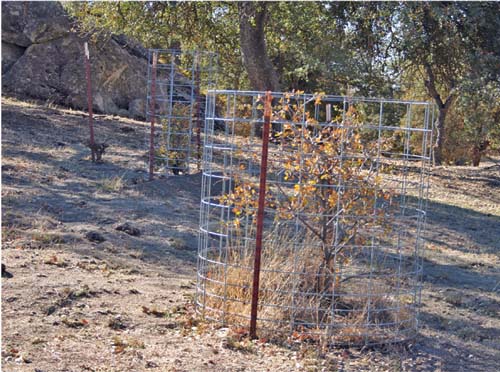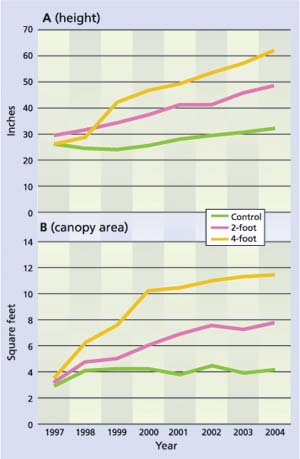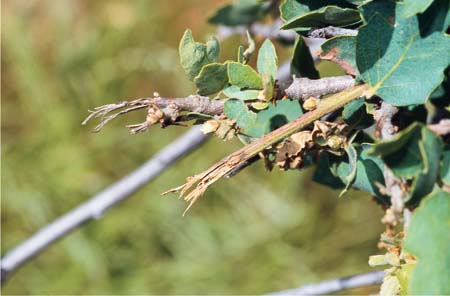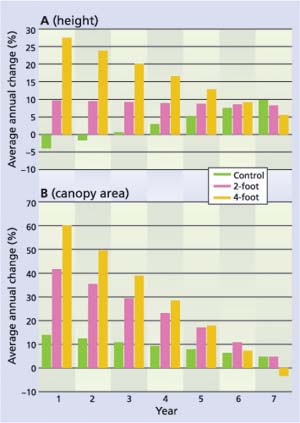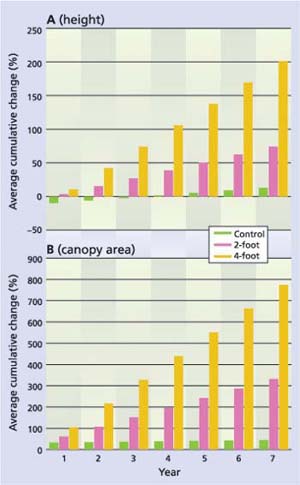All Issues
Exclosure size affects young blue oak seedling growth
Publication Information
California Agriculture 61(1):16-19. https://doi.org/10.3733/ca.v061n01p16
Published January 01, 2007
PDF | Citation | Permissions
NALT Keywords
Abstract
Blue oak, a tree native only to California, is notoriously slow-growing, and its low regeneration rate has prompted concern about the species' future survival in some areas of the state. We studied the use of fencing (exclosures) to protect seedlings from herbivores and promote faster growth. Placing exclosures 2 and 4 feet in diameter around blue oak seedlings increased their height and canopy area when compared to a control without exclosures. The 4-foot exclosures increased growth (height and canopy area) compared to the 2-foot exclosures. It appeared that exclosures reduced damage from both wild and domestic herbivores, resulting in accelerated growth rates.
Full text
The lack of regeneration by blue oak in some areas of California and the small numbers of seedlings in the 1-to-10-foot (30-centimeter-to-3-meter) height class has caused concern among landowners and environmentalists ( see pages 7 and 11 ). Considerable research has been conducted to evaluate methods for increasing the growth of blue oak (Quercus douglasii) seedlings and small trees. In Regenerating Rangeland Oaks in California (2001), McCreary summarized research on various aspects of oak regeneration, including planting acorns, protecting seedlings during early growth stages, and fencing to exclude livestock and wildlife from native and planted oak seedlings. He found that such exclosures were effective in reducing browsing by wildlife and domestic livestock.
Many owners of oak rangeland have native blue oaks that are 1 to 6 feet (0.3 to 2 meters) tall, but that are growing very slowly. Also, landowners may have seedlings in certain areas of their property where they would like to have large trees in the future. These landowners need a method to increase the growth of individual trees.
Blue oak, a California native tree, grows extremely slowly, and young seedlings are particularly vulnerable to livestock grazing. Simple fencing exclosures help to protect seedlings and increase the growth of individual trees.
This study was initiated to develop a method for increasing the growth of selected blue oak seedlings. The study compared the growth of unprotected seedlings to those within 2-foot (0.6-meter) and 4-foot (1.2-meter) diameter exclosures. The hypothesis was that 4-foot exclosures would protect the horizontal growth of seedlings more than 2-foot exclosures, increasing the biomass of seedlings.
Study sites, statistical methods
In 1997, eight oak woodland sites were identified on four ranches in the southern Sierra Nevada foothills of Kern County. Ranches 1 and 4 had two sites each, ranch 2 had one site, and ranch 3 had three sites. Each site had 10 to 15 seedlings per acre (25 to 38 per hectare) that were 10 to 30 inches (25 to 75 centimeters) tall. Three similarly sized seedlings from each site were randomly assigned to one of three treatments: control (no exclosure), 2-foot-diameter exclosure and 4-foot-diameter exclosure. Initial and yearly measurements were made for seedling height and canopy area in late June or early July, after the current year's height increase had slowed. Height measurements were taken from the seedling's base to the top of the tallest green shoot.
We assumed that the canopy of a seedling is approximately circular, so the canopy area was calculated using the formula for the area of a circle (πr2). The radius was determined by averaging the longest and shortest diameters of the seedling canopy and dividing by 2. Each seedling was examined to determine if there was girdling caused by rodents. Girdling is the removal of bark from all or part of the circumference of the tree, which in this study was visually observed up to 4 inches above ground level.
The exclosures were constructed using 0.25-inch (0.6 centimeter) welded-wire commercial cattle panels. The panels were 54 inches (1.4 meters) high by 16 feet (4.9 meters) long. The panels were cut in 8-foot (2.4-meter) lengths and molded into 2-foot-diameter circular exclosures. The 16-foot panels were molded into 4-foot-diameter circular exclosures. The exclosures were centered around the seedlings and two T-posts held them in place.
The annual percentage change in height and canopy area were calculated using this formula: ([Yeari+1 - Yeari]/ Yeari) X 100, and the accumulated percentage change for the two experimental parameters was calculated using this formula: ([Yeari - Year1]/Year1) X 100, with i being the study year from 2 through 8.
The effects of exclosure diameter on the annual as well as accumulated height and canopy area of blue oak seedlings were determined by using a generalized least squares regression model (Pinhiero and Bates 2000). Using a backward-stepping algorithm, year, exclosure diameter (0, 2 or 4 feet) and their interaction term functioned as covariates, with a P value of less than 0.05 as the cutoff point for retention of the term in the model. If the interaction term was found to be significant, all single-level terms were retained in the model. In addition, an exponential variance function was added to control heteroscedacity (unequal variance) of within-group errors, along with an adjustment for serial correlation induced by repeated annual measurements on the same set of seedlings. Each of the four outcome variables (annual height, cumulative change in height, annual canopy area and cumulative change in canopy area) was evaluated separately.
Seedling height and canopy
A comparison of the raw data for average seedling heights (fig. 1A) and canopy areas (fig. 1B) for the three treatments (0, 2- and 4-foot exclosures) during the study's 8 years shows generally slow but steady growth for all treatments. Using the regression equations to represent average trends in the raw data, seedling height increased more than 20% per year during the first few years for the 4-foot exclosure group, with reduced rates of growth thereafter (fig. 2A). In comparison, the 2-foot group had a relatively steady annual height increase of about 9% to 10%. The control group lost height during the first few years (-3.9%) — potentially due to herbivory — but exhibited annual height increases of 5% to 10% during the last few years of the study. By the 7th year, all groups were growing about the same, with 7% to 9% annual height change (fig. 2A).
Fig. 1 Raw data for (A) height and (B) canopy area of blue oak seedlings for three treatments, 1997 to 2004.
Fig. 2. Generalized least squares (GLS) regression model showing the average trend in the raw data for the percentage annual change in blue oak seedling (A) height and (B) canopy area for three treatments, 1997 to 2004.
Fig. 3 Fig. 3. GLS regression model showing the average trend in raw data for cumulative percentage change in blue oak seedling (A) height and (B) canopy area for three treatments, 1997 to 2004.
Using the regression equations to represent average trends in the raw data, there was a significantly higher increase in canopy area during the 1st year for the 2-foot and 4-foot groups compared to the control group (control = 13.9%; 2 foot = 41.6%; and 4 foot = 60.1%) (fig. 2B). By the 5th year the annual change in canopy area was only 7.8% for the control group, compared to 17.0% for the 2-foot group and 17.8% for the 4-foot group.
The percentage accumulated height and accumulated canopy area for the three groups were not significantly different, but there were significant interactions between year and exclosure diameter. Using the regression equations to represent average trends in the raw data, by the 7th year the height of seedlings in the 4-foot group had increased by 200%; the 2-foot group had increased by 74%; and the control seedlings had also increased, but by only 12.8% (fig. 3A). The average trends for canopy area follow the same general pattern (control = 44.0%; 2 foot = 331%; and 4 foot = 775%) (fig. 3B).
The substantially greater increase in height and canopy growth during the first several years of the study exhibited by the seedlings in the 2-foot and 4-foot exclosures compared to the seedlings outside of exclosures (control group) resulted in greater height and wider canopies for those seedlings located inside the 2-foot or 4-foot exclosures. Examination of the raw data demonstrates that in 2003 the average height for a seedling in the 4-foot exclosure group was about 58 inches, and the average height for those in the control was about 30 inches (figs. 1A and 1B).
Using the regression equations to represent average trends in the raw data, the annual percentage growth was 10% for the control group and 5.6% for the 4-foot group in 2004. Therefore, the average increase in height for the control group in 2004 would be about 3.0 inches (30 inches x 10%). The average increase in height for the 4-foot group would be 3.25 inches (58 inches x 5.6%). The greater annual growth rate for the 4-foot and 2-foot exclosure groups resulted in taller seedlings in these groups than in the control during the first years of the study. As a result, by 2004 the average cumulative growth was much greater for the 4-foot and 2-foot groups, even though the average annual growth was similar for the three groups by the end of the study.
Blue oak seedlings protected for 8 years by 2- and 4-foot exclosures had significantly wider canopies and greater heights than those in the unprotected control group. This simple and relatively inexpensive method provides rangeland owners and managers with an effective option for encouraging oak regeneration.
The hypothesis that the 4-foot exclosure treatment would allow seedlings to grow more when compared to the 2-foot exclosure treatment was confirmed. The average increase in height for seedlings in the 2-foot group was only 19.4 inches, while that for the 4-foot group was 36.7 inches.
Making the assumption that an increase in canopy area translates into an increase in leaf area, and consequently more growth (height and canopy area), helps to explain why the seedlings in the 4-foot group were taller after 8 years. The average canopy area for the 4-foot group increased more during the first several years of the study (fig. 1B). By the end of the study, the average canopy areas for the 4-foot and 2-foot groups were 11.5 square feet and 7.8 square feet, respectively.
Threats from animals
Mice, rats and/or voles can be a troublesome threat to blue oak seedlings. These animals thrive in dense vegetation, groundcover and thatch (McCreary 2001). Rodents such as voles can girdle oak seedling shoots, either killing the aboveground stem or slowing growth but not killing the seedling. Phillips and McDougald (1998) compared the rodent girdling of blue oak seedlings growing in 16-foot-by-16-foot livestock and wildlife exclosures to those in open grazing areas. The 1998 comparison was made in a habitat similar to that of this study. After 5 years, 85% of the seedlings growing in the large exclosures had been girdled, compared to 21% in the grazed areas.
In this study, we used much smaller exclosures compared to the larger 16-foot-by-16-foot ones in the Phillips and McDougald (1998) study. We did not observe any seedling girdling in the present study, apparently because there was not sufficient groundcover in the exclosures for good rodent habitat. This supports McCreary's (2001) conclusion that without adequate habitat, vole damage to oak seedlings is eliminated or reduced.
In general, the smaller 2-foot and 4-foot exclosures used in our study provided an effective method for limiting damage to blue oak seedlings from both small (voles) and large (wild and domestic) animals. Exclosures of excessive diameter, such as 16-feet-by-16-feet, may limit herbivory from large animals but lead to excessive girdling by rodents.



